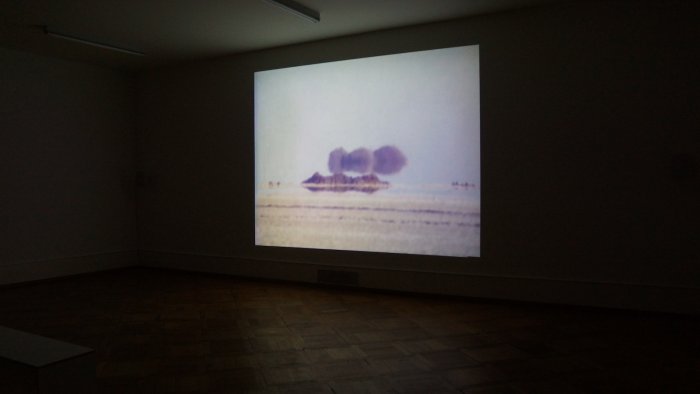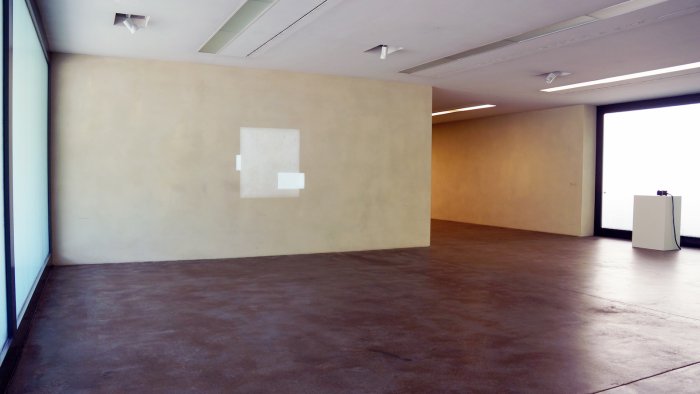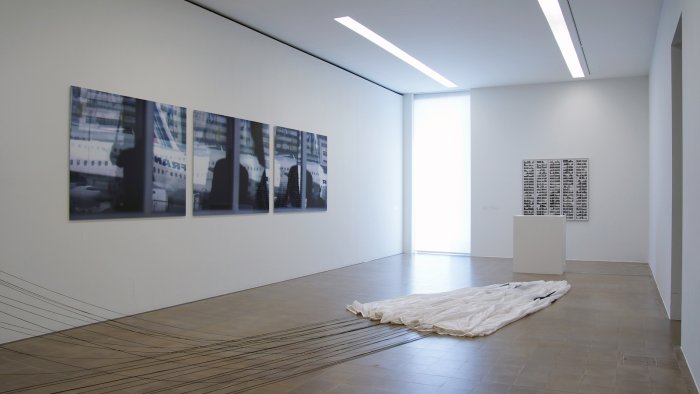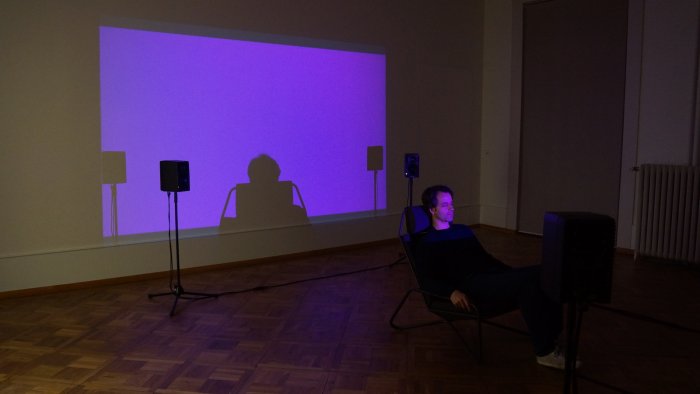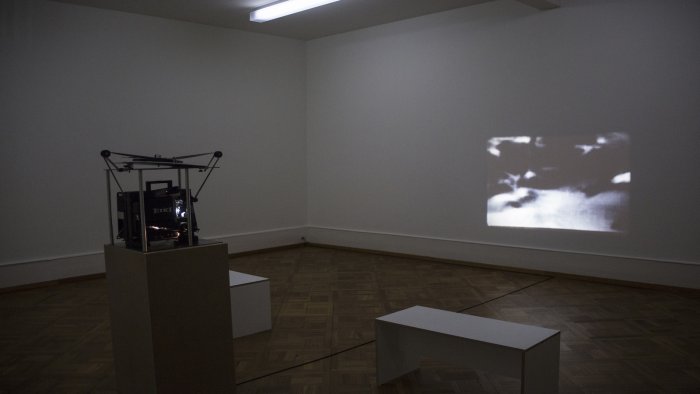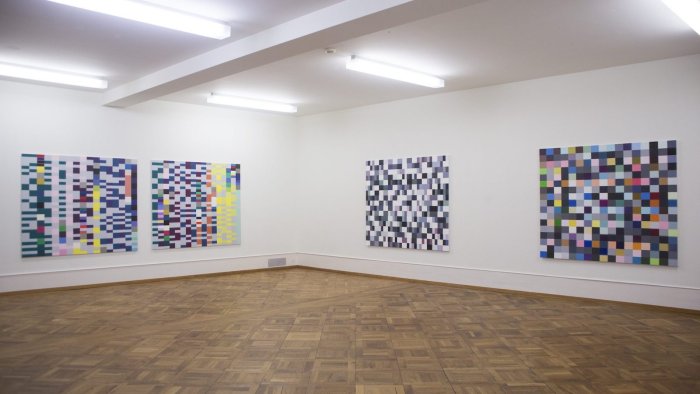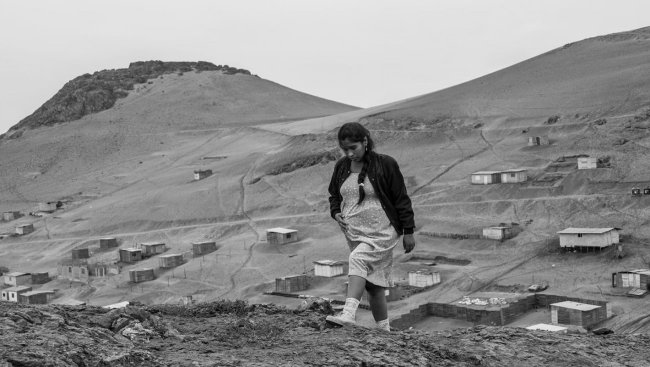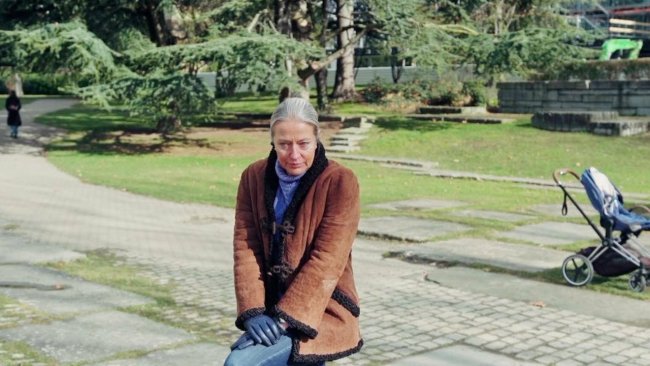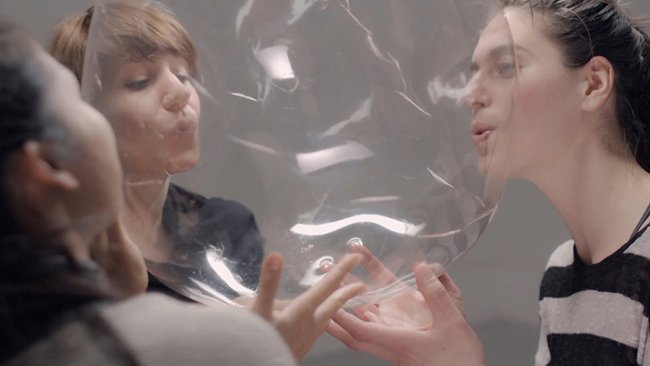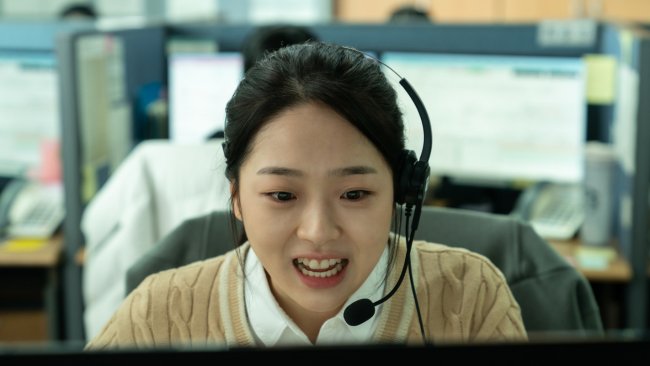Ellen Fellmann | Extended Compositions
[…] Fellmann’s “composition” is neither a collage nor a synthetic symphony, but it can be seen – or heard, or just sensed – as a variation on the theme of the relationship between image and sound.
[…] The connection between synesthesia and abstraction is well known and has been studied extensively, and it reveals the most important conceptual layer of an exhibition like Extended Compositions. This should not be viewed as a source of difficulty but it simply provides the occasion for us to reflect on our perceptions.
[…] This exhibition is a wonderful exercise that provides us with the reappropriation of the grammar of moving images, which amounts to an extension of the possibilities of their perception and, accordingly, to an extension of the possible meanings which can be drawn from them.
Text: Giuseppe Di Salvatore | Audio/Video: Ruth Baettig
As we enter the PasquArt Art Center in Biel/Bienne, we see Hans Richter’s renowned film, Rhythmus 21, setting the rhythm as the passpartout idea that binds the very different works throughout the exhibit: films and videos, sound installations, drawings, and sculptures. Hans Richter’s film is without sound, consisting only of a rhythmic pulsation of images; in conrast to this, in the last large room that we visit, the Poma room, Janet Cardiff’s The Forty Part Motet (A Reworking of “Spem in Alium”, by Thomas Tallis 1556) does not display an image, but consists of forty loudspeakers, one for each member of an invisible choir singing Tallis’ composition. Here the rhythm lies in the music and in our walking by and around the loudspeakers, which makes us discover a constantly changing musical flow. The curator, Ellen Fellmann, stresses the movement as the key theme, which is aimed at conceiving an exhibition that is organized through a specific path. Following this itinerary, we have the impression that Fellmann, who is an artist herself, used the various artistic contributions – among which, old renowned artists are placed together with younger generations of artists – to compose one gigantic piece that delivers several synesthetic experiences, that is, experiences that can stimulate different senses at the same time.
Between Richter’s “no-sound” film and Cardiff’s “no-image” sound installation we experience all kinds of relationships between image and sound, as all of the selected works explicitly play with this relationship and highlight it as a unifiying theme. In this context, even the absence of sound or image holds a specific function for each work. Fellmann’s “composition” is neither a collage nor a synthetic symphony, but it can be seen – or heard, or just sensed – as a variation on the theme of the relationship between image and sound. Through its variations, the idea of rhythm emerges as a sort of refrain and movement – the movement within each of the works as well as our own movement through the exhibit – emerges as a sort of basso continuo. The moments when the visitor concentrates her/himself on the discovery of autonomous works can be thought of as the arias of the composition, while the recitatives appear in the associations at play between the different works that the visitor experiences while moving and therefore in the perception of the whole space where the works are installed. In this way, the visitor becomes a part of the choreography that animates the architecture of the exhibition space.
Extended Composition is an exhibition that will always reveal different accents according to the synesthetic sensibility of each person. My personal path through the exhibition was punctuated by the following variations, or accents: rhythm as the principle force behind the composition of images (Hans Richter, Susanne Schuricht, Idris Khan, Dieter Appelt); images as by-products of the experience of sounds (Gregor Hildebrandt, Silva Reichwein, William Engelen, Frank Badur); the composition of sounds as an image-based construction (Terry Fox, Ellen Fellmann); the experience of sounds accompanied only by imagined images (Leo Hofmann, Samuel Emde, Nora Ringgenberg, Janet Cardiff); images following the movements of sounds (Hiromi Ishii, Ellen Fellmann); the tension and gap between sounds and images (Simeon Sigg, Bill Viola, Bruce Naumann, Mariateresa Sartori, Mika Rottenberg); sounds reinforcing the editing as the main principle in the composition of moving images (Barbara Kasten, Stan Brakhage, Samuel Beckett, Joachim Schönfeldt, Christoph Girardet & Matthias Müller).
This spontaneous process of grouping depends on the selective abstraction and the abstractive pairing that is activated in a synesthetic experience. The connection between synesthesia and abstraction is well known and has been studied extensively, and it reveals the most important conceptual layer of an exhibition like Extended Compositions. This should not be viewed as a source of difficulty but it simply provides the occasion for us to reflect on our perceptions. The result of this conceptual reflection is an increased sensibility in hearing and seeing. Independently of the impressive individual works one can discover in the exhibit, Extended Compositions, as a whole, has an educational force: its conceptual power becomes an awakening of the senses.
For this reason, the exhibition has a lot of potential with respect to the perception of moving images in particular. Film is often seen as the “natural” combination of sound and image, but in fact, this reception comes from the dominance of the narrative, naturalistic, and illusionist forms that films have taken since the first Hollywood boom. The experiences we have with the artistic works gathered and “composed” in Extended Compositions encourage the consideration of the relationship between sound and image as something not to be taken for granted; this is the creative task of the work we experience and it is our task as perceivers as well. This exhibition is a wonderful exercise that provides us with the reappropriation of the grammar of moving images, which amounts to an extension of the possibilities of their perception and, accordingly, to an extension of the possible meanings which can be drawn from them. In a way, looking at a film as if it were an extended composition is another way of making “expanded cinema”: not stretching the limits of the screen into the space, but expanding the capacities of our own perception of moving images. The film as extended composition becomes an intensive perception of the film.
*
The artists of «Extended Compositions»: Dieter Appelt, Frank Badur, Samuel Beckett, Sonia Boyce, Stan Brakhage, Janet Cardiff, Samuel Emde, William Engelen, Ellen Fellmann, Terry Fox, Christoph Girardet & Matthias Müller, Gregor Hildebrandt, Leo Hofmann, Hiromi Ishii, Barbara Kasten, Idris Khan, Bruce Nauman, Carsten Nicolai, Raha Raissnia, Silva Reichwein, Hans Richter, Nora Ringgenberg, Mika Rottenberg, Mariateresa Sartori, Joachim Schönfeldt, Susanne Schuricht, Simeon Sigg, Bill Viola
© Fotos Ellen Fellmann & Jolie Lovens
Info
Extended Compositions | Exhibition | Curator: Ellen Fellmann | Kunsthaus Centre d’Art PasquArt Biel/Bienne | 8/4-11/6/2017
First published: May 23, 2017
